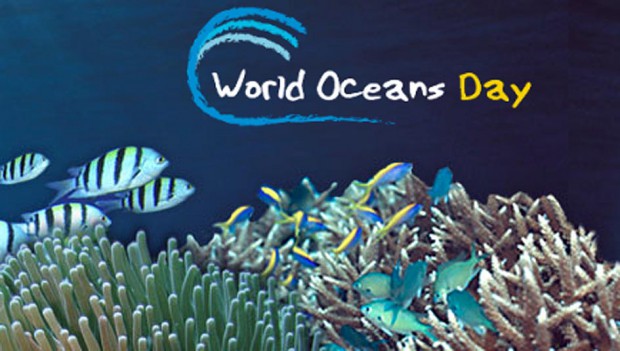
World Oceans Day – looking deeper into Sri Lanka’s sea areas

Today marks World Ocean Day.
A look at the current concerns facing Sri Lanka…
For this island nation, the importance of the ocean is vital to the economy, ecology and tourism. Sri Lanka’s rich marine life includes one of the largest populations of blue whales in the world
The ocean area belonging to Sri Lanka extends 200 nautical miles off shore, covering an area that is eight times larger than Sri Lanka’s land, and upon which Sri Lanka’s economy and environment depends.
The country’s fisheries Industry provides livelihoods for in excess of 2.6 million coastal communities.And yet Sri Lanka is one of the worst plastic polluters in the world.
News1st spoke to Marine Biologist Daniel Fernando regarding this situation
He noted that Sri Lanka stands as one of the largest plastic polluters in the world and that the main reason for the cause is due to the inability to recycle plastic.
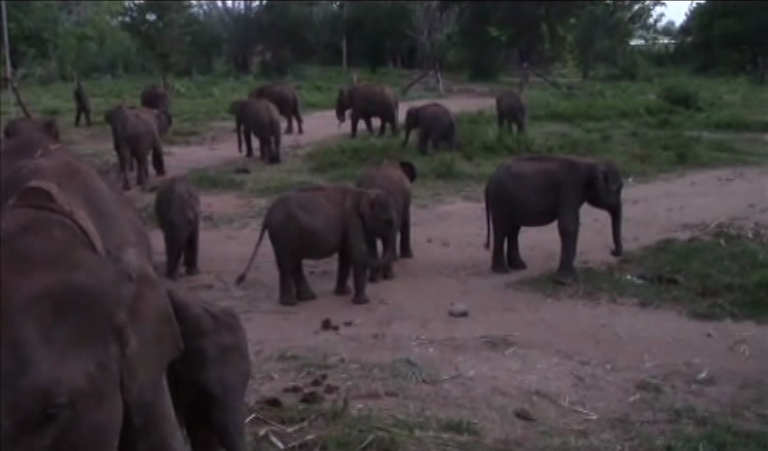
Seven baby elephants released to Udawalawa

Seven baby elephants who have been raised for five years at Udawalawa Eth Athurusevana have been released to Udawalawa National Wildlife Park under the patronage of Minister Gamini Jayawickrama Perera. Baby elephants who meet with various injuries, are being brought to Udawalawa Eth Ahurusevana, and provided treatment and protection. Seven baby elephants who were looked after for five years at Eth Athurusevana were released to the Gonaviddagala area of Udawalawa National Wildlife Park. Four of them were released this morning after religious activities. The other three were released this afternoon. A group of officials including the Wildlife Director General S.K. Pathirana were present on this occasion.
Source – 10/06/2017, ITN News,See more at – https://www.itnnews.lk/local-news/seven-baby-elephants-released-to-udawalawa/

Bitter protests over sugar cane
Protests are growing over a private sugar cane cultivation in Dehigama, Rideemali-yadda, where lands from the Madhuru Oya forest will be allocated. Environmentalists and villagers conducted a religious ritual to protect the trees of the forest. According to their belief the trees cannot be felled after these religious observances are held.
A large number of Buddhist priests visited the Madhuru Oya forest amidst chanting of seth pirith to perform the ritual. The trees were draped with robes and ordained as part of the ritual. More than 62,000 acres are to be allocated for the sugar cane plantation.
Pix and text by Nayanajeewa Bandara
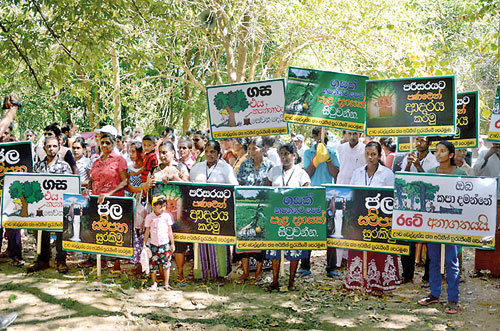
Protesters say sugar cane cultivation will affect water supply
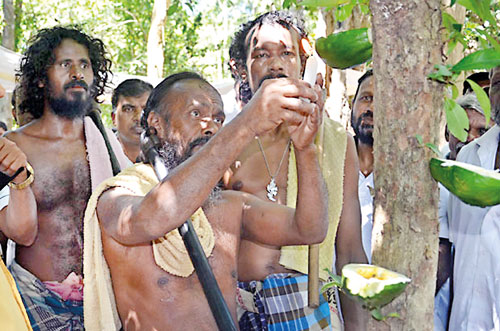
A member of the indigenous clan lights a makeshift lamp affixed to a tree
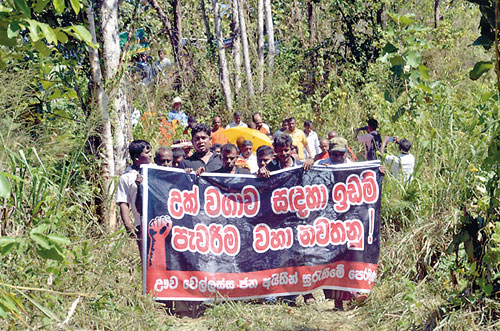
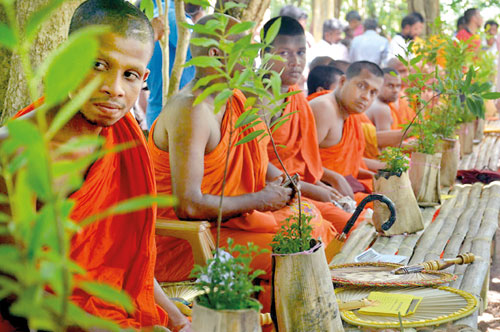
Young monks prepare to plant saplings
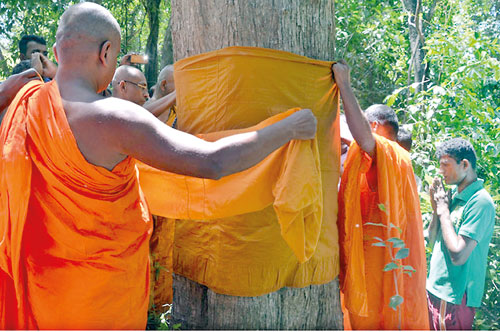
A monk drapes a saffron coloured robe on a tree
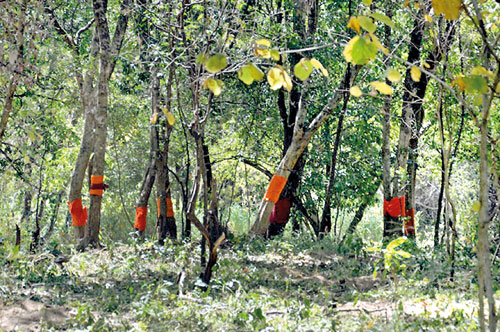
The trees in the forest are draped in saffron robes as part of a religious ritual to protect them from being felled
Source – 11/06/2017, The Sunday Times, See more at -http://www.sundaytimes.lk/170611/news/bitter-protests-over-sugar-cane-244794.html
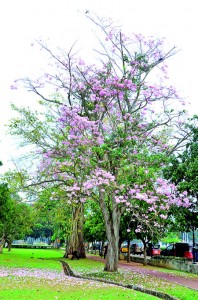
‘I think that I shall never see a poem lovely as a tree’
Our political leaders seem to admire and take Singapore as a model. Yet, consider how much planning, resources and energy have gone into branding Singapore as the garden city. They would have started from scratch and amidst all that concrete and high rise construction in a limited space, Singapore’s leaders have done admirably to create an empathy in their people for the planted natural surroundings and their care. It is also high diplomacy because Singapore depends heavily on tourism and needs to keep constantly adding to its attractions.
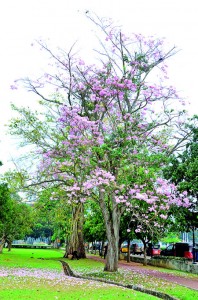 Here, just look at the splendour we have inherited, the giant Flamboyants showering red and orange flowers on pavements, the yellow Ehela hanging down in clusters, the Mara trees also shedding gold on the concrete below, not to mention the ubiquitous Araliya and Bougainvillea in all colours. Have you seen just now the pink of the Tabebuia is beginning to show, pleasing to the eye amidst the grey clouds and rain . Yet why do we not appreciate these gifts of nature – only a few committed stalwarts like the Ruk Rakaganno organisation is dedicated to “protect the trees” amidst all the drive to cut them down for more concrete and asphalt!
Here, just look at the splendour we have inherited, the giant Flamboyants showering red and orange flowers on pavements, the yellow Ehela hanging down in clusters, the Mara trees also shedding gold on the concrete below, not to mention the ubiquitous Araliya and Bougainvillea in all colours. Have you seen just now the pink of the Tabebuia is beginning to show, pleasing to the eye amidst the grey clouds and rain . Yet why do we not appreciate these gifts of nature – only a few committed stalwarts like the Ruk Rakaganno organisation is dedicated to “protect the trees” amidst all the drive to cut them down for more concrete and asphalt!
Why is that people no longer care for and know about the trees around them? Trees are living entities which are connected to all life forms. What damage we do to trees will eventually impact us all.
The National Trust has invited experts to publish coffee table books on Flowering Plants and draw attention to what is Growing in the Garden. These books have much value for our country’s promotional efforts but the tourism authorities seem unaware of our natural wealth and only pursue the monetary goals. How many of our VIPs have considered giving these books as gifts instead of the token package of consumable tea ? In contrast, in all my diplomatic postings, the gifts from the highest in the land usually consisted of glossy coffee table books highlighting their country’s heritage. The National Trust is supporting a project to publish a book on heritage trees and to nameboard and conserve all the heritage trees in the vicinity of Colombo. It is a project which the Municipality and the UDA all should support, because in truth we are a city in a garden. However, the situation is so bad that some say don’t name the trees because once observed there is a value, it will be cut down!
Singapore has turned its Botanical Gardens into a World Heritage site with all the research, financing and diplomatic skills involved, in order to enhance its country brand and tourism appeal. Here, in Peradeniya we have one of the oldest botanical gardens in Asia with a heritage going back to the ancient kings and modern assets of research, education and public amenities. Have we even taken one step to putting this treasure on the world map? There is a wonderful collection in the Arboretum of botanical specimen paintings (some of which are in Singapore) by a talented family of Sri Lankans going back several generations – why have these paintings not been published?
Some years ago, retiring from the diplomatic service, I had begun to work on a book on the gardens of Sri Lanka, unaware at the time of the rich heritage and variety of gardens in the country. At the time, my colleagues were sceptical and kept asking what is the connection between gardens and diplomacy? Yet in truth, in ancient times, gardens were the site of most diplomatic meetings, assemblies and functions. Mauryan Emperor Ashoka was known to hold public hearings in gardens much like the town hall meetings today. In this week of Poson we recall that the Sri Lankan King met Emperor Ashoka’s envoy Mahinda Thera in Mihintale. From the Mahawansa we can gather that this was not a chance meeting as in legend but probably pre-arranged in a garden of mango trees ( amba vanaya). The Mahawansa also relates that the first public sermons on Buddhism were pronounced in the palace gardens in Anuradhapura, (the elephant stables had also to be cleaned out to accommodate the huge throngs of people who came to listen) and the royal forest park was offered and accepted as a residence to the visiting high level delegation of monks.
Sri Lanka’s garden heritage includes a number of ancient monastic gardens, probably unique in Asia.These sites, carefully preserved by the Archaeological Department include Kaludiya Pokuna of which much has been written. Now it seems that some foolish Minister has actually conceived of a plan to turn it into a tourist hotel, over the objections of the Archaeological Department . There are rumours that an ancient frieze has already been damaged in the process. It seems our heritage treasures have no value for these ambitious politicians who only seem to want to make more money – shame!
Carefully preserved and protected heritage sites can be economically viable as numerous studies have shown. Yet when the thirst for revenue overcomes the care for managing the site properly, it can all end very badly. Pinnawela is one such project once born to protect the abandoned baby elephants now reduced to a circus for the tourists, displaying techniques of bottle feeding to one or two young elephants and in another corner one chained elephant being force-fed by tourists who buy baskets of fruit for this purpose. It’s surprising that the supervising vets have allowed these things to happen, completely defying the purpose for which Pinnawela was set up.
Today our public gardens are indispensable sites providing the “green lung” of the city and enabling recreation, rest and recovery from the urban confusion and pollution. So why is it that the Vihara Maha Devi Park for example is not showcased as a city asset where our foreign delegations should be invited to visit and walk around, like a museum? Those who are regular visitors for exercise in Vihara Maha Devi Park know the value of this great spot in the city, including the fascination of the younger generation for the resident bat colony. We need to give credit to the previous government for bringing down the railings and making the park a living part of the city.
Gardens, with the calming effects of harmony in nature, also serve to create peace after conflict. Imagine how much better would be a garden for people to come to terms with grief than a monument of cement and stone? In many other parts of the world, commemorative peace gardens are being created or re-born like the ancient rose garden in Kabul, reminding of how nature can help human beings reconcile with death and pain. So why not a peace garden in Jaffna with local trees and plants where grief, irrespective of race or creed, can find solace.
Source – 11/06/2017, the sunday Times, see more at – http://www.sundaytimes.lk/170611/plus/i-think-that-i-shall-never-see-a-poem-lovely-as-a-tree-244283.html
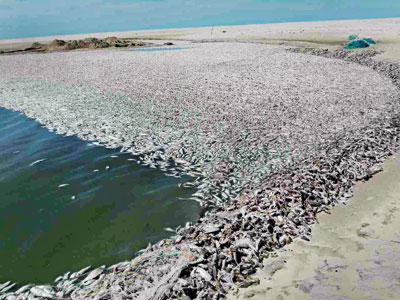
Nandikadal lagoon fish perished without oxygen, says NARA
Nandikadal lagoon fish perished without oxygen, says NARA
By Malaka Rodrigo
Thousands of fish seen floating in the Nandikadal and another nearby lagoon in Mullativu this week died because of a lack of oxygen, experts say.
Nandikadal is where a decisive battle against LTTE terrorism took place in May 2009. So the news of the dead fish triggered more curiosity.
The Fisheries Ministry directed the National Aquatic Resources Research and Development Agency to investigate. One June 4, a team led by NARA’s head of Environmental Studies S A M Azmi visited Nandikadal.

Sea of dead fish. Pic by Thayalan
“Different species of fish ranging from shrimp, eels to modha were found in the mass fish grave. We tested the water in the lagoon and found that the oxygen level is zero in the affected section of the lagoon. So literally, these fish died due to depletion of oxygen in the water,” Mr Azmi revealed.
They did not find any bacterial infection.
He also pointed out that this is a common phenomenon.
The water level of the Nandikadal lagoon had dropped below the sand bar as a result of the drought and this prevented the flow of water between the sea and the lagoon.
“Usually a sudden rain that brings lot of nitrogen and fertilizer to a water body triggers an algal boom – a rapid growth of microscopic algae. The algae soon die and the decomposition process consumes a lot of the oxygen dissolved in the water rapidly depleting the lifeline of the fish in the water. Once in a while fish in Beira lake and other inland water bodies, too, die due to this phenomenon according to the NARA expert. The area in Mullativu got some rains on the 29th of May, but there was little time for such algae bloom,” he said.
Mr. Azmi believes disturbances of the bottom sediments due to activities such as fishing could have triggered different oxygen consuming processes that led to the sudden depleting of oxygen in the Nandikadal lagoon. He said it is rarely that they record a zero oxygen level in a body of water, adding that even in cases of fish deaths in other areas due to low oxygen, the level is not zero.
The NARA team advised that a section of the sand bar be excavated to let the sea water flow into the lagoon.
Mr Azmi said the NARA team heard from locals that this is a common occurrence at this time of year. “So it is advisable to cut this barrier every year around the 15th of May,” Mr Azmi said.
This could happen in shallow coastal areas as well. These areas are called ‘dead zones’ resulting in deaths of fish in the open ocean as well.

Source – 11/06/2017, The Sunday Times, See more at – http://www.sundaytimes.lk/170611/news/nandikadal-lagoon-fish-perished-without-oxygen-says-nara-244783.html
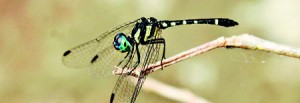
Tracking those darting beauties across Montane forests
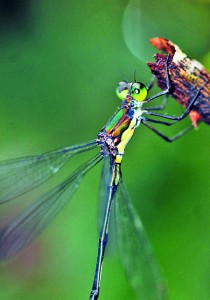
Sri Lanka Emerald Spreadwing- Sinhalestes orientalis
The emerald beauty is his favourite and he is quick to show off on his smart phone these “power machines” with their gossamer wings and long body shapes, on which helicopters have been modelled, to anyone who indicates even the slightest interest.
While many are fascinated by the fragile wonder of butterflies, few follow or even study their cousins – Dragonflies and their twins, Damselflies.
This is the lacuna that 28-year-old Amila Prasanna Sumanapala has attempted to fill, with a strong helping hand from Dilmah Conservation to place before the uninitiated this little studied group of insects. (See box please)
Of the Odonata order, around the world there are over 6,000 species of dragonflies and damselflies, with Sri Lanka home to 129 species of which 56 are endemics. They are everywhere, says Amila, with home-gardens ‘harbouring’ at least 10 species in their different glorious colours and more if there is a pond.
His work in the Peak Wilderness and other montane forests have also shed light on new species, rare species as well as species not spotted in a very long time, leading to research pieces in many reputed journals. Back in 2012, he re-discovered the species, Sri Lanka Emerald Spreadwing not recorded for 150 years.
“When I saw it, I didn’t know it was that fellow, although I did realize that it was unusual. I was familiar with many species and thought that it was either new or had been lost for a while,” he says.
Interesting little nuggets of information about dragonflies are presented by Amila – like all insects their life-cycle comprises egg, larva, molt and adult. The larval stage is completely aquatic and they are found in “all sorts” of still-water bodies including wewas (tanks), home-garden ponds, marshes and paddyfields and also flowing-water such as irrigation canals, small streamlets and streams. Some larvae can also tolerate a level of salinity and thus can be found even in lagoons.
Did you know that dragonflies are carnivorous, he asks, describing how the larvae would feed on mosquito larvae acting as a biological control, while the adults would swoop and catch other flying insects including the bane of humankind, the mosquitoes.
“Dragonflies are very important for the environment as they are excellent indicators of the health of aquatic ecosystems,” explains Amila. Some species lay eggs in water or on aquatic plants, some species need clean water and a few others even in polluted water. One day soon we should have special indexes for them.
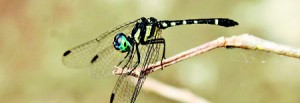
Yerbury’s Elf- Tetrathemis yerburii
Lamenting that rapid urbanization is causing harm to their environment, he points out that the number of dragonflies and damselflies seems to be dropping. They are bioindicators giving us strong signals on the health of the environment and as such this needs to be heeded seriously.
Dragonflies, one of the largest living insects, are very important as scientific subjects particularly in the aviation field, he says, adding that his ardent wish for Sri Lanka with its abundance of dragonflies is to make it a ‘dragonfly tourism’ destination.
Amila’s interests as a boy, however, centred on birds rather than insects. Growing up in Boralesgamuwa, getting his primary education at the Ananda Shastralaya in Kotte and later at Royal College, a love of nature came about as he sat glued to the Discovery Channels on television.
When Amila was 13, the University of Colombo celebrated its 60th anniversary in 2002, and brought him under the influence of well-known environmentalist and birder, Prof. Sarath Kotagama. It was this little flame that ignited and sent him in the direction of biology with a keen interest to study animals and work in conservation, which he followed up with a Special Degree in Environmental Conservation and Management at the University of Kelaniya.
By 2008, Amila was part of the Young Biologists’ Association based at the Natural History Museum in Colombo. Later he would accompany other scientists who would photograph dragonflies only for identification but not for in-depth study. By 2011, he was peering at them quite closely as a hobby.
Conceding that many consider butterflies to be more charismatic, Amila who works as an independent biologist laughingly puts me on the right track, tactfully ignoring my ignorance on dragonflies, when he says that these large easily-observable insects are “very colourful”.
Travelling alone or with a small group of like-minded friends, Amila’s favourite haunts are the Peak Wilderness Sanctuary and the Sinharaja Rainforest.
They travel very light carrying with them a few cooking utensils and sleeping bags, sometimes spending the night in ‘ambalamas’ or roughing out in tents, surviving on one rice meal a day. At other times they would munch on biscuits or dry slices of bread, swallowed with gulps of water.
“Yes,” smiles Amila, the days and nights spent on the trail of dragonflies make his girlfriend jealous but fortunately for him, she is heavily into lichens, so they do have similar interests.
Everything the reader wishes to know about the dragonfly or damselfly From his favourite, the Sri Lanka Emerald Spreadwing (Sinhalestes orientalis) , ‘A Field Guide to the Dragonflies and Damselflies’ by Amila Sumanapala packs within its 174 pages everything and more that we need to know about 105 of these brilliantly-hued insects.It is byson, Amila, to his father, H.G.D. Sumanapala that the Field Guide is presented at the launch of this book on the rainy evening of May 30 at the Dilmah Exceptional Tea Lounge at the Water’s Edge Hotel in Battaramulla amidst a handful of invitees.  Easy to grasp with detailed sketches and photographs, the Field Guide not only gives a brief introduction to Odonata, but also touches on Sri Lanka’s climate, geography and biodiversity before dealing with the diversity of Odonata in the country, a checklist on them, their conservation, family and species profiles and also their habitats.Simple explanations and something learned about these insects, for anyone who flips through the pages of this Field Guide, with what Dilmah Founder Merrill J. Fernando states in the book ringing true: “I hope that with this publication future generations will be enlightened on the importance of this species and the need for their conservation and inspire with it a new generation of enthusiasts who will take on this responsibility and help restore dragonfly populations.” Easy to grasp with detailed sketches and photographs, the Field Guide not only gives a brief introduction to Odonata, but also touches on Sri Lanka’s climate, geography and biodiversity before dealing with the diversity of Odonata in the country, a checklist on them, their conservation, family and species profiles and also their habitats.Simple explanations and something learned about these insects, for anyone who flips through the pages of this Field Guide, with what Dilmah Founder Merrill J. Fernando states in the book ringing true: “I hope that with this publication future generations will be enlightened on the importance of this species and the need for their conservation and inspire with it a new generation of enthusiasts who will take on this responsibility and help restore dragonfly populations.”
Those who pick up the Field Guide will find it very easy to navigate as the format is reader-friendly. The ‘familycolourcode’ can be spotted even when the Field Guide is closed. Everything the reader wishes to know about the dragonfly or damselfly profiled on a particular page is all there – images of both the male and the female; its common name and scientific name; its flight season highlighted by month; its size (abdomen andhind-wing); a distribution map; whether large, medium or small; its national conservation status (ranging from extinct to near-threatened tonot-evaluated); and abundance status (ranging from very common to very rare). Like the latest on dragonflies and damselflies, Dilmah Conservation has put outcolourfuland handy books on a wide range of topics, a line-up of 11, including on common spiders, common butterflies, snakes both deadly and venomous, lichens, traditional communities – the Ahikuntaka and indigenous communities – the Veddahs. This is in keeping with the objectives of Dilmah Conservation initiated in 2007, to incorporate environmental and wildlife conservation efforts into the work of the M.J.F. Charitable Foundation, which primarily focuses on social justice. The objectives are to produce a collection of scientific publications on a range of biodiversity-related topics to help create greater awareness. 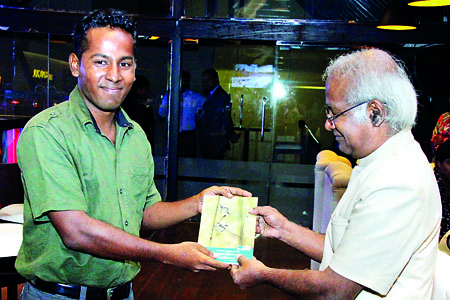
From son to father: Amila’s presentation. Pic by Indika Handuwala Getting back to the Field Guide, it is a must-have not only for those who are about to softly tread in the flight-path of these creatures but also thosealready-fascinated by them. While Amila is lured by the ‘very rare’ Sri Lanka Emerald Spreadwing and there is awide-rangefor you to pick from such as the green-blue mixed ‘uncommon’ Elephant Emperor; black with yellow markings ‘rare’ Sri Lanka Wijaya’s Scissortail; and bright red-and-yellow ‘very rare’ Sri Lanka VermilionForestorto name a few, for me the humble and ‘very common’ black beauty with luminous metallic blue or green on the hind-wings, Sri Lanka Shining Gossamerwing, isfirstchoice. |
Source – 11/06/2017, The Sunday Times, see more at -http://www.sundaytimes.lk/170611/plus/tracking-those-darting-beauties-across-montane-forests-244272.html
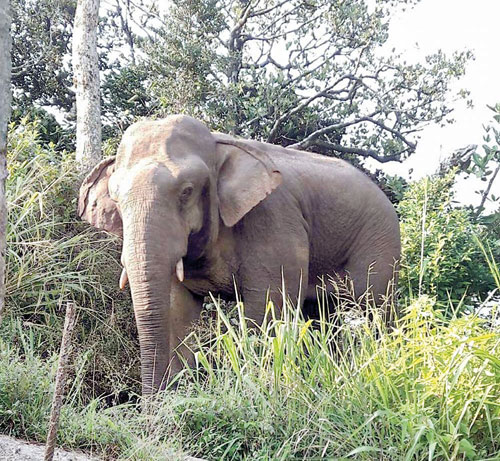
Protect unique Sinharaja with a strict eco-tourism plan
Local and foreign visitors roam this rainforest, home of elephant and leopard, without restriction
By Kumudini Hettiarachchi
A stunning image of a majestic elephant emerging from a mist-laden forest fills the screen…………a little while later along the same pathway tread a group of carefree tourists, both local and foreign. These are the ‘Vistas of Eastern Sinharaja’ and the dangers of not monitoring human visitors to this Protected Area that the Galle Wildlife Conservation Society’s Madura De Silva brought to the audience at an important panel discussion on ‘Biodiversity & Sustainable Tourism’ on May 22 at the HNB Auditorium in Colombo.
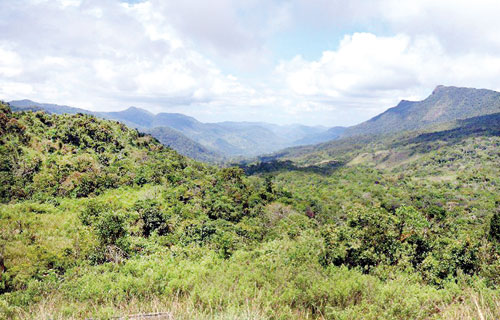
Spectacular and mysterious Sinharaja — a World Heritage Site
The event was organised by Biodiversity Sri Lanka (BSL) on International Day for Biological Diversity with four panellists dealing with ‘Vistas of Sinharaja’; ‘Dollars for Deeds’; ‘Challenges in the Yala National Park (NP)’; and ‘Significance of the coasts around us’. The discussion that followed was moderated by BSL Advisor Shiranee Yasaratne. (Last week, we published ‘Challenges in Yala’ and ‘Significance of coasts’.)
Before Mr. De Silva takes up the major issues that need to be addressed at Sinharaja which falls under the mandate of the Forest Department, he waxes eloquent on this World Heritage Site consisting of tropical sub-montane rainforests and pathana grasslands. Eastern Sinharaja is “unique” due to its geography at an elevation range of 575-1,170m and meteorological patterns of an annual rainfall of between 3,600mm and 5,000mm and annual temperatures ranging from 17-27ºC.
Other factors that make it unique are eight species of point endemic amphibians and four species of lizards. It was at the Morningside Forest Reserve that Mr. De Silva himself and his team also came upon a new species of a point endemic plant, Aponogeton kannangarae.
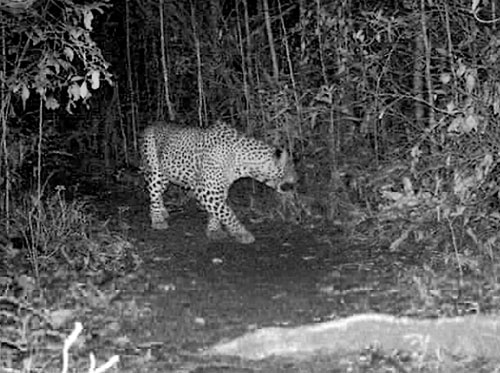
Wet-Zone leopards ‘captured’ by camera traps at Sinharaja in the ongoing research
He elaborates on the Low-land Wet Zone Leopard Project which has as its aim the establishment of a strategic conservation plan for the Big Cats of this area, with the Field Research Centre at Enasalwatta. In this major public-private partnership among the Wildlife Conservation Society of Galle, the Open University of Sri Lanka, the Nations Trust Bank and the Rainforest Ecolodge, Wet Zone leopards are the focus as they are poorly studied, unlike those in the Dry Zone. The studies involve identification of individual leopards by their spots through images from camera-traps, pug-marks and scat analysis. The first-year study results have helped ascertain the leopard distribution in eastern Sinharaja.
Thereafter, Mr. De Silva gives guidelines on how a model for responsible eco-tourism could be established. Urging that there should be an in-depth tour-guide training programme, he says that their knowledge on rainforest ecology and identification of fauna and flora should be improved, while also making them aware of the legal aspects that need to be strictly adhered to under the Fauna and Flora Ordinance when people visit Protected Areas.
“This is while there is a need not only to educate but also make the communities living on the boundaries to participate in the conservation project,” he says, adding that even visitors should be kept in the loop so that they too could provide their expertise and data for the conservation project.
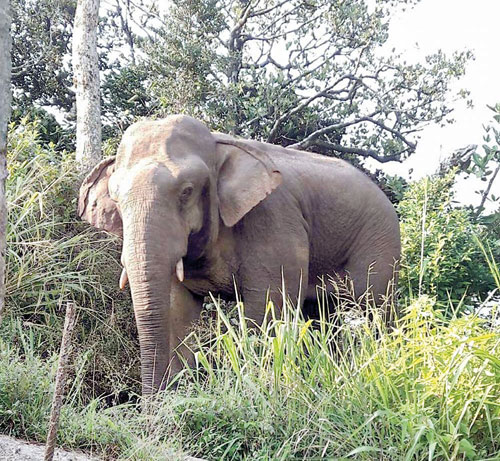
A Sinharaja tusker in all its majesty
| ‘Dollars for Deeds’ conservation programme of Tangalle’s AnantaraIt is Anantara Hotel’s Dilan Bandara from Tangalle who focuses on how they have just embarked on a ‘Dollars for Deeds’ programme for conservation, with the strong support of the International Union for Conservation of Nature (IUCN).
The vision of the programme is for the hotel to match the contribution of guests, $ for $ (dollar for dollar), for conservation. To have solid evidence to show the guests, the hotel has already begun the programme, before seeking guest contributions. Before detailing the programme, Mr. Bandara describes the ‘modern’ traveller as being highly individual, tech-savvy and open-minded. On a mission to live life to the full, he/she seeks the exceptional, thriving in the new, at ease riding horseback on a dusty trail in the Andes as in a spa in the Maldives or enjoying the serendipity of metropolitan encounters in a downtown neighbourhood. “We create journeys of inspiring, surprising moments and enjoyment — elevating all senses and connecting with the environment and culture of each one of our locations. Anantara is a luxury hospitality brand for modern travellers, connecting them to genuine places, people and stories,” he says, stressing that corporate social responsibility (CSR) is a way of life for them. With sustainability development being an integral part of Anantara’s organizational strategy, they are committed to developing ‘The Dollars for Deeds’ programme in Tangalle, he says, laying down their objectives and proposed activities. Conduct in-situ conservation of marine turtles, thus contributing to conserving globally-threatened species. The proposed activities include identifyingthe relevant stakeholders such as hotel staff, government line agencies, and local communities who will be involved in monitoring of turtle-nesting and conducting a workshop on the guidelines that should be followed for recording turtle-nesting.
Tiny turtles waddle towards the sea on the beach of Tangalle Raise awareness on marine turtle conservation and enhancement of field-level capacity of the Department of Wildlife Conservation (DWC) to conduct in-situ conservation of marine turtles. The proposed activities include keeping exhibits — such as eight display panels and models of the five turtle species visiting Sri Lankan shores — at the information corner of the proposed DWC Beat Office in Rekawa and establishing a ‘Media Wall’ at a selected location of the resort to display information/short documentaries on turtles, a section/panel with project related activities to introduce the ‘Dollars for Deeds’ programme. Enhance the representation of native species of flora within the property and establish a typical coastal habitat for native coastal species. Build the capacity of the resort for conservation and sustainability (hotel staff, local communities and guests). The proposed activities include aFund to be utilised for conservation of globally-threatened marine turtles, Asian elephants etc. |
Source – 11/06/2017,The Sunday Times, See more at – http://www.sundaytimes.lk/170611/news/protect-unique-sinharaja-with-a-strict-eco-tourism-plan-244827.html
Mr. Miththapala stressing on the importance of environment, biodiversity, sustainability, and conservation for the tourism industry
Mr. Sri Lal Miththapala, an eminent personality in the tourism sector, former chairman of the Tourist Hotel Association of Sri Lanka, begins his career as an electrical engineer by profession and he eventually served in the tourism sector for nearly 23 years. He is expressing about the importance of environment, biodiversity, sustainability, and conservation for the tourism industry.
https://youtu.be/a_Yw-g_Yd4I
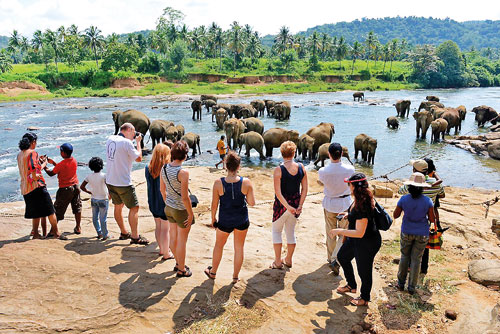
Price wars, oversupply cloud country’s thriving leisure sector
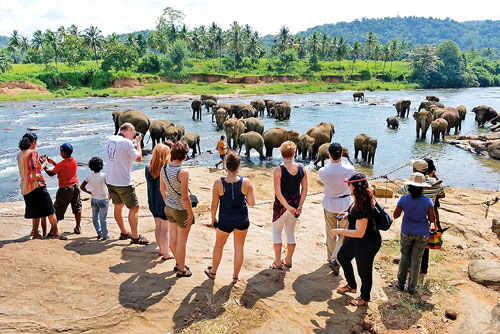
These concerns have been reflected by many hotel companies namely John Keells, Aitken Spence, Hemas Hotels, Grand Hotel (Nuwara Eliya) and Pegasus Reef in their 2016/17 annual reports issued over the past fortnight. The following is a synopsis of the concerns:
- Setting proper standards
Nuwara Hotels veteran Chairman George Ondatjee:
“Our tourism policy framework is not properly designed to meet the current situation. To meet the 2.5 million tourists in 2016 there was a shortage of rooms supply in the island, but I personally feel that while the Sri Lanka Tourism Development Authority has given approvals to build tourist hotels in major cities it has not been properly planned as there is an oversupply situation. As a result price wars have begun and hoteliers find it difficult to meet their obligations such as meeting the energy bills, payroll and other fixed overheads, finally guests suffer for value for money services cannot be given to them.
Our neighbouring countries will reap the harvest and attract more tourists to their destination for a lower rates. Sri Lanka has failed to market the country as one that offers a different product from that of the Maldives to both Chinese and Italians who travel to the Maldives in large numbers. In this connection, another issue that arises is which kind of tourists are we targeting – high-end, middle or the lower-end. Some argue that we must target the higher-end and focus on smaller number of tourists who are high spenders and bring more foreign exchange earnings. To attract high end tourists our service standards should improve for that government should give more concessions to this industry without taking more taxes. New standards should be set for new, upcoming hotels about the facilities, only then can we have a quality product.”
- Informal sector unregulated
 Aitken Spence Deputy Chairman J.M.S. Brito:
Aitken Spence Deputy Chairman J.M.S. Brito:
“Considering the environment in which the local hotels operate, the informal sector, which is largely unregulated, continued to pose obstacles in the development of a level playing field in the industry. Inadequate regulations have meant that the informal sector is not properly governed in terms of desired industry standards and as a result do not fall within the regulated tax regime, which gives them an unfair advantage and would impact the legitimate foreign exchange earnings of the country. Moreover they are often not aligned with the Sri Lanka Tourism Development Authority (SLTDA) and in most cases do not participate in the collective efforts by the formal sector to build a credible platform for the country’s tourism industry. As such, I continue to urge the authorities to put in place necessary regulatory controls that would create a level playing field for the betterment of the industry. Further, I cannot overemphasize the importance of having a cohesive country strategy in order to strengthen the country’s value proposition as a tourist destination.”
- Urgent need for a national plan
Dolphin Hotels (Hemas) Chairman Abbas Esufally:
“From a macro perspective, it is clear the industry needs a comprehensive national strategy to sustain continuous industry growth and to target specific growth opportunities. Global geopolitical and technology changes are creating new opportunities and challenges for the Sri Lankan tourism industry. The instability in parts of the Middle East and some other parts of the world, coupled with exchange rate volatility, is changing global travel paradigms. More people are opting to visit safer regions of the world, including ours which is considered relatively stable. Increasing digitisation of lifestyles is also generating opportunities for a more flexible and cost efficient tourism business. New technology applications are driving reservations, hotel design and hotel operations for leaner, more efficient functioning.
However, the domestic travel and tourism industry is already facing some serious challenges. Competition in Sri Lanka is intensifying in certain areas where there is capacity oversupply. In this situation, maintaining price levels, revenues and occupancy, is a challenge. On the other end of the spectrum, the informal sector is gaining market share using a lower-cost operating model. The informal business sector is outside the tax net, while the tax burden on the formal tourism sector companies is currently over 29 per cent. This unequal playing field puts the formal sector, which is better regulated for quality standards relating to health, food hygiene, fire and safety at a significant cost disadvantage.
Sri Lanka requires a structured national plan, which is crucial if we are to succeed in the current globally competitive environment.
We should also look at the arrival numbers from a more qualitative perspective. Arrivals should not be the only measure of the industry Rising cost structures in the formal sector are also eroding overall country competitiveness. Our regional competitor destinations, such as Thailand, Bali, Malaysia, Vietnam, etc offer a similar, or better, product at a cheaper price. This poses a serious sustainability concern for our industry.”
- Steep increase in room supply
Pegasus Reef Hotel Chairman Chandima Gunawardena:
“Competition is intensifying across the industry with a large number of graded rooms being pumped into the market at a fast pace. In an environment characterised by such stiff competitiveness, it is distressing to see the unregulated informal tourism sector still enjoying unfair advantages. While the Government’s decision to impose mandatory minimum standards on such accommodation is commendable, I hope to see the fast and smooth implementation of such decisions in the foreseeable future.
Headwinds of competition remain challenging amid tough operating conditions.
Specifically, there is a steep increase in room supply visible in and around Colombo, where most of the star-class hotels are offering rates as low as US$75-80, hence going forward Pegasus Reef hotel would be operating in such an environment identified with intense price competition.”
- Focus on online bookings
John Keells Hotels Chairman Susantha Ratnayake:
“Growth in the informal accommodation sector in the Maldives and Sri Lanka is expected to continue, together with an increase in star category rooms.
In order to combat pressure from competition, the company will continue to focus on enhancing online bookings with online travel agents and its own web site, coupled with a focus on digital marketing initiatives. Additionally, there will be focus on sales strategies targeting selected cities in India through our representatives in India to drive the MICE market, particularly events and weddings.”
(Feizal)
Source – 11,06,2017, The Sunday Times, see more at – http://www.sundaytimes.lk/170611/business-times/price-wars-oversupply-cloud-countrys-thriving-leisure-sector-244480.html

Two jumbos rescued
 Two elephants fell into the Z-C canal of the Maduru Oya in Manampitiya were rescued successfully and released to the Pimburaththewa reserve by Veheragala Wildlife officials on Thursday.
Two elephants fell into the Z-C canal of the Maduru Oya in Manampitiya were rescued successfully and released to the Pimburaththewa reserve by Veheragala Wildlife officials on Thursday.
by Nimal Jayaratna
Source – 08/06/2017,DailyMirror, see more at – http://www.dailymirror.lk/article/Two-jumbos-rescued-130486.html




